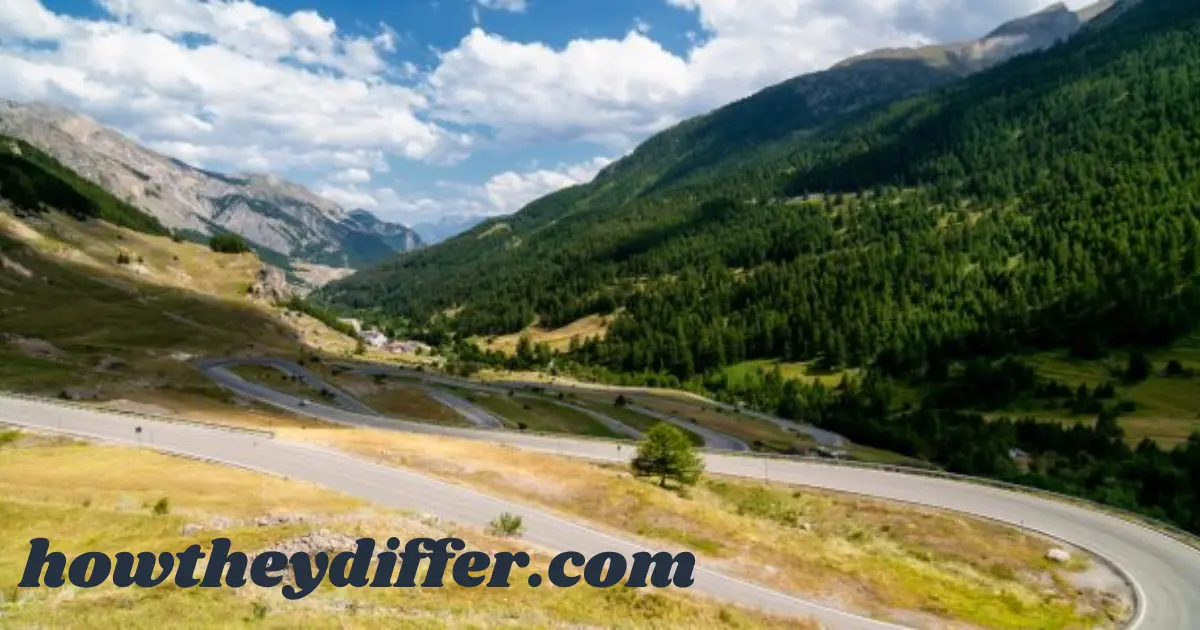Have you ever watched the Tour de France and heard the commentators talking about “cols” and “côtes”? Maybe you’ve seen these words on signs while driving through a mountainous area.
These terms might sound a bit confusing, but they actually describe different types of inclines. Understanding the difference between a col and a côte can be helpful if you’re a cyclist, a hiker, or just someone who likes to learn new things!
Think of it like this: you know the difference between a hill and a mountain, right? Well, “col” and “côte” are French words that help us describe different kinds of uphill climbs, just like we use “hill” and “mountain” in English.
In this article, we’ll break down the differences between cols and côtes in a way that’s easy to understand, even if you’re new to cycling or hiking.
What is a Col?
A col is a high point or pass in a mountain range. Imagine it like a saddle between two peaks. It’s the lowest point between two higher areas, kind of like a valley in the sky! Cols are often found along roads that travel through mountains, and they can be quite challenging for cyclists to climb.
- Think of it like this: Imagine two giants standing side-by-side. The col is the dip between their heads!
- Example: Some famous cols include the Col du Tourmalet and the Col d’Aubisque in the Pyrenees Mountains.
What is a Côte?
A côte is simply a slope or a hill. It’s any upward incline on a road, and it can be short or long, steep or gentle. Côtes are often found in hilly areas, and they can be a good test of a cyclist’s strength and endurance.
- Think of it like this: If you’ve ever walked up a steep street in your town, you’ve climbed a côte!
- Example: You’ll find côtes all over the world, from the rolling hills of Tuscany to the steep streets of San Francisco.
Col vs. Côte: Spotting the Difference
Now that you know the basic definitions of col and côte, let’s look at some of the key differences between the two:
| Feature | Col | Côte |
|---|---|---|
| Elevation | Usually high | Can be high or low |
| Location | Mountain range | Any hilly or mountainous area |
| Shape | Lowest point between two peaks | Any upward incline |
| Road | Often a road over the pass | Any road with an uphill section |
| Difficulty | Can be very challenging | Varies in difficulty |
As you can see, cols are generally higher and more challenging than côtes. They are also found specifically in mountain ranges, while côtes can be found anywhere with an incline.
Why is it Important to Know the Difference?
Understanding the difference between a col and a côte can be helpful for a number of reasons:
- Cycling: Cyclists need to know the difference so they can prepare for the challenges of different types of climbs. A col will require different gears and pacing than a côte.
- Hiking: Hikers also need to be aware of the terrain they will be covering. A col might involve a longer, more gradual climb, while a côte could be a short, steep ascent.
- Travel: If you’re planning a trip to a mountainous area, knowing the difference can help you understand the landscape and choose the right routes for your activities.
Cols and Côtes in the Tour de France
You might be wondering why these French words are used to describe hills and mountains. It’s because the terms are commonly used in professional cycling races, like the Tour de France, which takes place in France and neighboring countries.
In the Tour de France, cols and côtes are categorized based on their difficulty. This helps organizers award points to the best climbers in the race. The harder the climb, the more points a cyclist earns for reaching the top first!
- Hors catégorie (HC): These are the most difficult climbs, often featuring steep gradients and long distances. They are “beyond category”!
- Category 1: These are still very difficult climbs, but not quite as challenging as HC climbs.
- Category 2, 3, and 4: These categories represent progressively easier climbs.
So, the next time you watch the Tour de France, listen for the commentators mentioning cols and côtes. You’ll have a better understanding of the challenges the cyclists are facing!
Conclusion
To sum it up, a col is a high mountain pass, like a valley in the sky, while a côte is any uphill slope on a road. Cols are usually more challenging to climb than côtes, and they are found specifically in mountain ranges.
Understanding the difference between these two terms can be useful for cyclists, hikers, and anyone interested in exploring mountainous areas.
FAQs
What is the highest col in the world?
The highest col in the world is generally considered to be Marsimik La, at an elevation of 5,582 meters (18,314 feet) in the Himalayas.
Is a col always higher than a côte?
Generally, yes. Cols are high mountain passes, while côtes can be any uphill slope.7 However, some côtes can be quite high, especially in mountainous areas.
What is the difference between a col and a mountain pass?
The terms “col” and “mountain pass” are often used interchangeably. Both refer to the lowest point between two higher peaks in a mountain range.
Why are cols important for cyclists?
Cols present a significant challenge for cyclists due to their steep gradients and high altitudes. They are often key stages in races like the Tour de France.
Where can I find more information about cols and côtes?
Websites and books about cycling and hiking often have information about cols and côtes. You can also find information on online mapping tools and travel websites.
